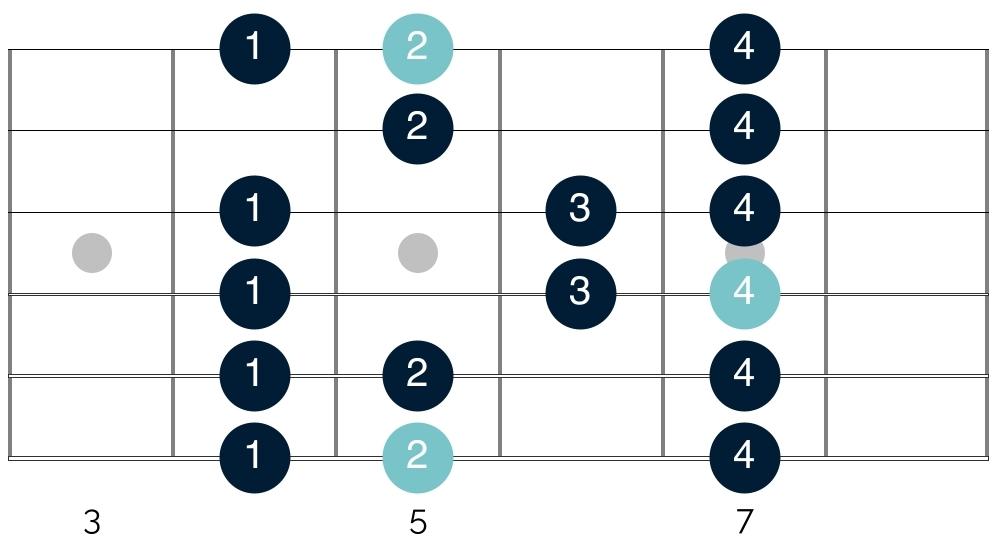Strap in, strummers, because we’re about to embark on a wild and fretful journey through the tangled mess that is the guitar scales-important-top-reasons-revealed/” title=”Why are Guitar Scales Important? Top Reasons Revealed”>fretboard. If you’ve ever felt like a lost sailor trying to navigate the endless sea of frets, fear not! We’ve got the essential scales that will have you shredding like a rock god in no time. So grab your guitar, grab your pick, and let’s dive headfirst into the bumpy, yet exhilarating world of navigating the guitar fretboard.
Contents
- 1 Understanding the Guitar Fretboard Layout
- 2 The Major Scale: Foundation of Western Music
- 3 Minor Scales: Exploring Emotional Depths
- 4 Pentatonic Scales: The Key to Effortless Soloing
- 5 Blues Scales: Adding Soul to Your Playing
- 6 Chromatic Scale: Mastering Fretboard Movement
- 7 Visualizing Scale Patterns Across the Fretboard
- 8 FAQs
- 9 Rock on and Master the Fretboard!
Understanding the Guitar Fretboard Layout
Alright, folks. Let’s dive into the mystical world of the guitar fretboard layout. Now, this fretboard might seem like a land of confusion at first, but fear not! We’re here to guide you through this labyrinth of strings and frets.
First things first, let’s talk about those frets. They’re the squiggly lines that run perpendicular to the strings. You’ll often hear people talking about fret numbers – these are just markers to help you find your way around. Think of them like breadcrumbs, but less edible.
Now, when it comes to playing actual notes on the fretboard, it’s all about those finger placements. Each fret represents a semitone, or half-step, on the musical scale. So, when you press down on a fret with your finger, you’re essentially changing the length of the string and therefore the pitch of the note. It’s like musical magic at your fingertips!
Remember, practice makes perfect when it comes to . So, grab your guitar, unleash your inner rockstar, and start exploring the world of strings, frets, and notes. And hey, if all else fails, just pretend you meant to play that funky, off-key note – after all, it’s all about artistic expression, right?

The Major Scale: Foundation of Western Music
Ah, the major scale – the superhero of Western music, the foundation on which all melodies and harmonies are built. Without the major scale, we would be lost in a sea of dissonance and chaos, like a symphony orchestra without a conductor.
So, what exactly makes the major scale so special? Let me break it down for you in a way that even a tone-deaf cat could understand:
- Seven notes: The major scale is made up of seven distinct notes, each with its own unique flavor. Think of them as the Spice Girls of music – Scary, Sporty, Baby, Ginger, Posh, and, well, you get the idea.
- Happy vibes: The major scale is known for its cheerful and uplifting sound. It’s like the musical equivalent of a warm hug from a fluffy unicorn on a sunny day.
- Key signatures: Each major scale has a corresponding key signature, like a secret code that tells musicians which notes to play sharp or flat. It’s like musical Sudoku, but way more fun.
So, next time you’re humming your favorite tune or jamming out on your air guitar, remember to thank the major scale for keeping everything in harmony. After all, without it, music would just be a jumbled mess of random noises – and nobody wants that.
Minor Scales: Exploring Emotional Depths
Are you ready to take a deep dive into the world of minor scales? Get ready to explore the emotional depths of these musical wonders!
Minor scales are like the brooding teenagers of the music world – they’re moody, emotional, and full of depth. They can range from hauntingly beautiful to downright melancholic, allowing you to unleash your inner drama queen (or king) as you play.
Embrace the dark side with the eerie and mysterious sounds of the natural minor scale, or add a twist of spicy drama with the harmonic minor scale. And don’t forget about the exotic allure of the melodic minor scale, perfect for when you want to add a touch of sophistication to your musical compositions.
So grab your instrument of choice, tune in to some minor scale magic, and get ready to explore the emotional depths like never before. It’s time to unleash your inner musical emo and let those minor scales work their brooding magic!

Pentatonic Scales: The Key to Effortless Soloing
So, you want to take your guitar solos to the next level? Look no further than pentatonic scales – the secret weapon of every aspiring rockstar. These five-note wonders are like cheat codes for effortless soloing. Say goodbye to noodling around aimlessly and hello to shredding like a pro.
With pentatonic scales, you’ll be able to navigate the fretboard with ease, effortlessly weaving in and out of different keys like a musical ninja. No more getting stuck in one position or playing the same tired licks over and over again. The pentatonic scales are your ticket to freedom and expression.
Not convinced yet? Here are just a few reasons why pentatonic scales are the key to unlocking your soloing potential:
- Versatility: Pentatonic scales can be used in any genre – rock, blues, jazz, you name it. They’re like the Swiss Army knife of scales.
- Easy to learn: With only five notes to memorize, pentatonic scales are beginner-friendly. No need to spend hours practicing complex theory – just plug and play.
- Instant cool factor: There’s something undeniably badass about ripping a pentatonic solo. You’ll be the envy of all your friends and the star of every jam session.
So what are you waiting for? Grab your guitar, learn those pentatonic scales, and let the musical magic happen. Before you know it, you’ll be soloing like a champ and wondering why you didn’t discover the power of pentatonics sooner. Rock on!

Blues Scales: Adding Soul to Your Playing
So you’ve mastered the basics of playing the blues, but now you want to take your skills to the next level and add some soul to your playing. Well, look no further than the magical world of blues scales!
Blues scales are like the secret ingredient that can turn your bland playing into a flavorful feast for the ears. By incorporating these scales into your repertoire, you’ll unlock a whole new level of emotion and expression in your music.
But wait, there’s more! Not only do blues scales add soul to your playing, but they also give you the freedom to explore new melodic paths and create unique sounds that will set you apart from the crowd. With just a few simple tweaks and adjustments, you can transform your mundane licks into something truly special.
So don’t be afraid to dive into the world of blues scales and experiment with different combinations and variations. Let your creativity run wild and watch as your playing transforms from ordinary to extraordinary right before your very eyes. Trust me, your ears (and your audience) will thank you!
Chromatic Scale: Mastering Fretboard Movement
So you think you know your way around the fretboard, huh? Well, buckle up because we’re diving into the world of the chromatic scale! This bad boy is about to take your fretboard movement to a whole new level. Picture this: you’re effortlessly gliding up and down the neck like a pro, hitting every note with precision and finesse. That’s right, with the chromatic scale under your belt, you’ll be the envy of every guitarist in town.
Forget about sticking to the same old familiar patterns – it’s time to break free and explore every nook and cranny of the fretboard. The chromatic scale is like a treasure map, guiding you through all 12 unique pitches and unlocking a world of musical possibilities. With each step you take, you’ll be one step closer to becoming a fretboard ninja.
But beware, my fellow guitar warriors, mastering the chromatic scale is no walk in the park. It requires dedication, practice, and a whole lot of patience. Don’t expect to become a fretboard wizard overnight – it’s a journey, not a sprint. So grab your guitar, saddle up, and get ready to conquer the fretboard like never before. The chromatic scale awaits, are you ready to take on the challenge?
Visualizing Scale Patterns Across the Fretboard
In this section, we will embark on a journey to explore the vast expanse of the fretboard through visually mapping out scale patterns. Brace yourselves, fellow guitar enthusiasts, for we are about to dive into a world of musical exploration like never before!
Picture this: you’re wielding your trusty guitar, ready to conquer the fretboard with your newfound knowledge of scale patterns. As you navigate through the strings and frets, the patterns start to emerge like constellations in the night sky – each one unique, yet interconnected in a harmonious dance of notes.
With the help of our visual aids, you’ll be able to see how these patterns repeat and overlap across the fretboard, making it easier to navigate and improvise with confidence. No longer will you feel lost or overwhelmed by the sheer size of the fretboard – **you’ll be the master of your musical domain!**
So grab your guitar, strap in, and get ready to unlock the secrets of scale patterns across the fretboard. Who knows, you might just uncover a hidden gem of creativity that will take your playing to new heights. Embrace the challenge, embrace the scales, and let’s paint the fretboard with our unique musical fingerprints!
FAQs
Why is it important for beginners to learn scales on the guitar fretboard?
Well, if you want to sound like a rockstar and not like you’re just strumming random notes, then knowing your scales is key. It’s like having a treasure map to navigate through the fretboard and create killer solos.
What are some essential scales that beginners should start with?
Think of the Pentatonic scale as your best friend. It’s got all the cool sounds you need to kickstart your guitar journey. Plus, it’s like playing with training wheels – easy to learn, but with endless possibilities.
How can beginners practice these scales effectively?
Practice, practice, practice! Repetition is key when it comes to learning scales. Start slow, then gradually build up your speed. And don’t forget to jam along to your favorite tunes – it’s like eating your veggies with a side of fries.
Are there any shortcuts or tricks for mastering the fretboard?
Absolutely! The CAGED system is like a magic wand for unlocking the secrets of the fretboard. It’s like learning a secret code that will help you navigate through different keys effortlessly. Plus, it makes you look super cool in front of your bandmates.
How can beginners stay motivated when learning scales can feel repetitive?
Turn it into a game! Challenge yourself to learn a new scale every week or set a timer and see how many times you can play it perfectly in a row. And remember, even rockstars had to start somewhere -so keep shredding!
Rock on and Master the Fretboard!
Congratulations, budding guitarist! You are on your way to becoming a fretboard wizard with these essential scales. Keep practicing, keep jamming, and keep rocking out. Before you know it, you’ll be shredding like a pro and impressing all your friends. So grab your guitar, crank up the volume, and let the music take you on a wild ride. Who knows, maybe one day you’ll be headlining at Madison Square Garden. Keep on strumming, my friend!



